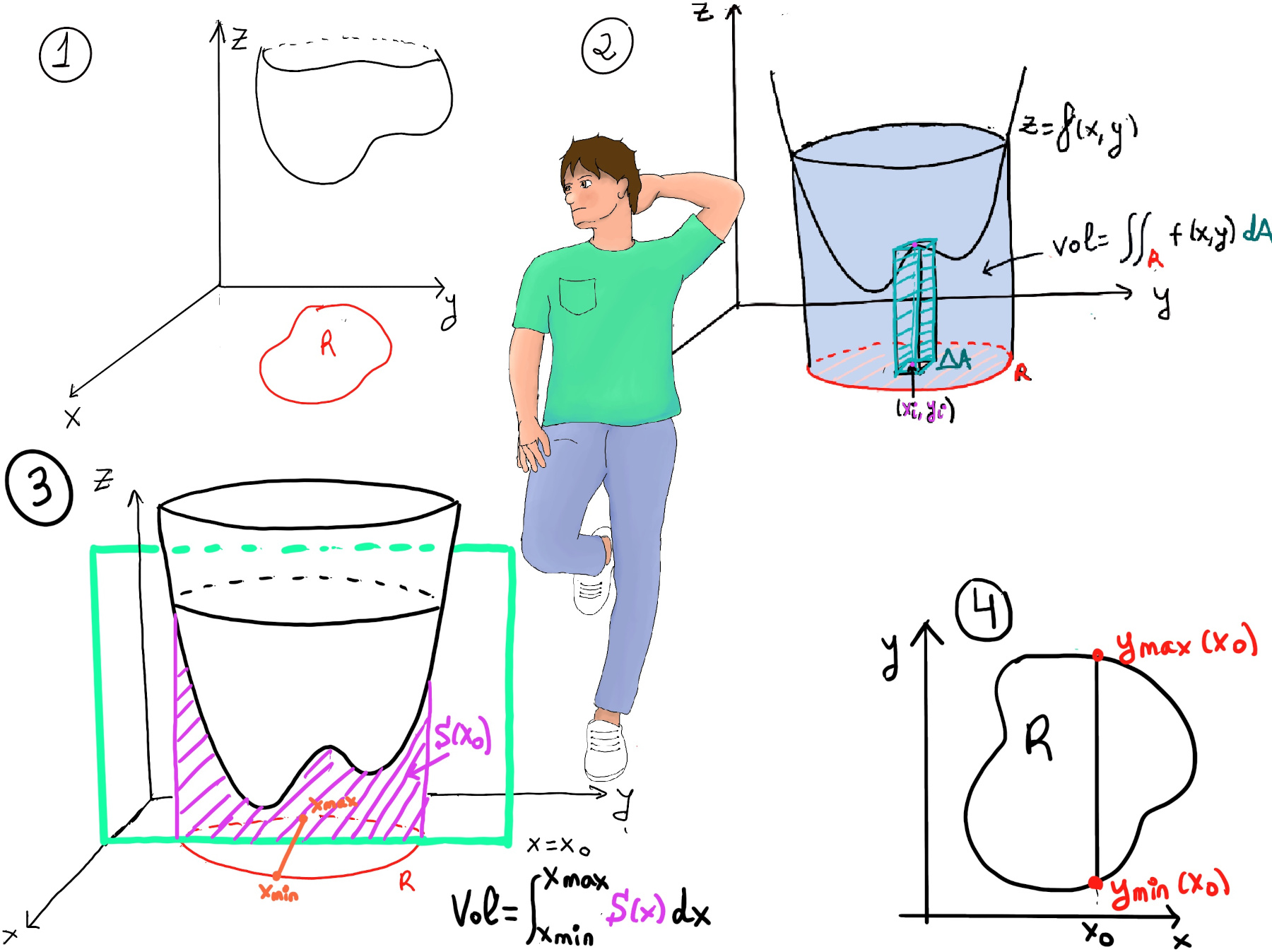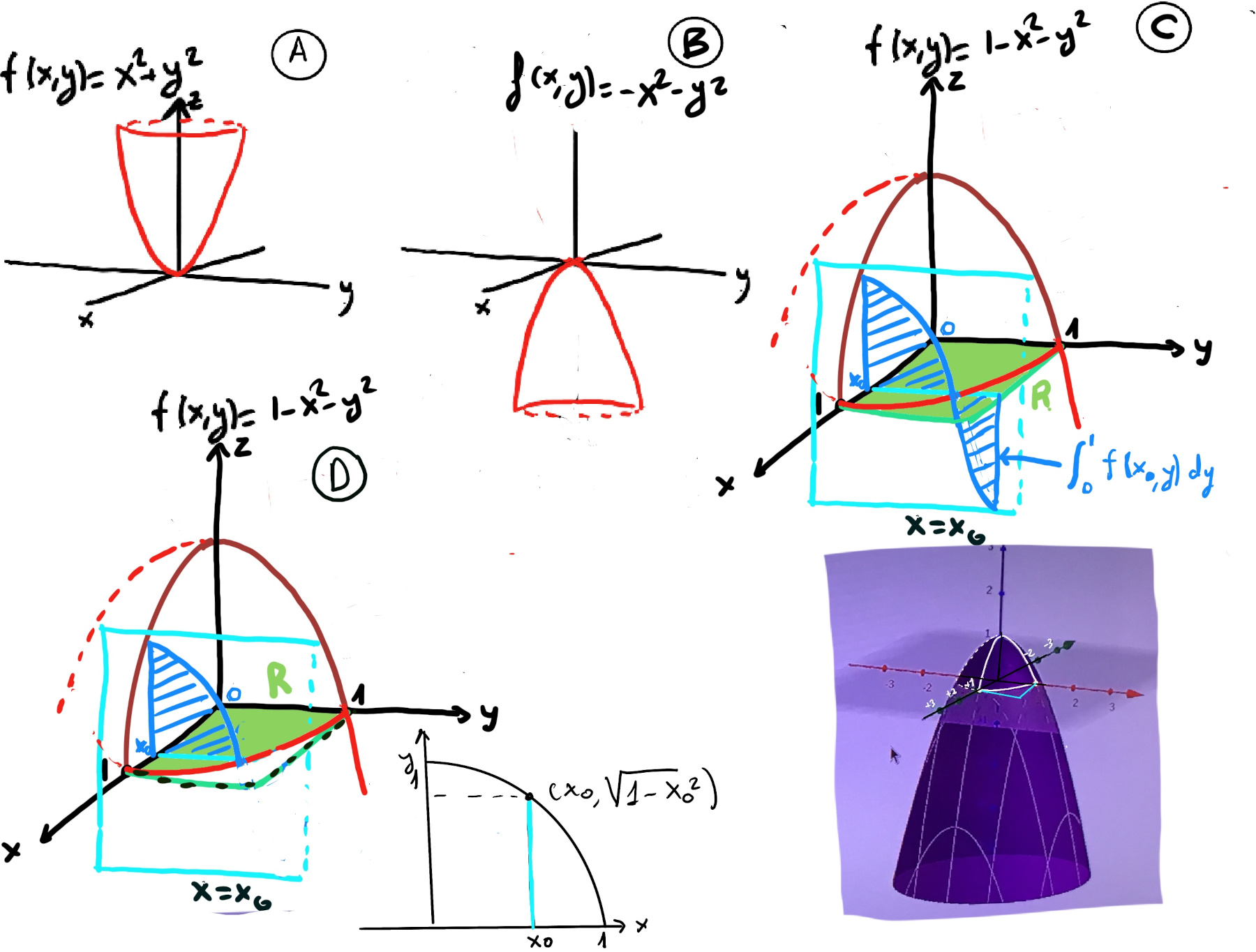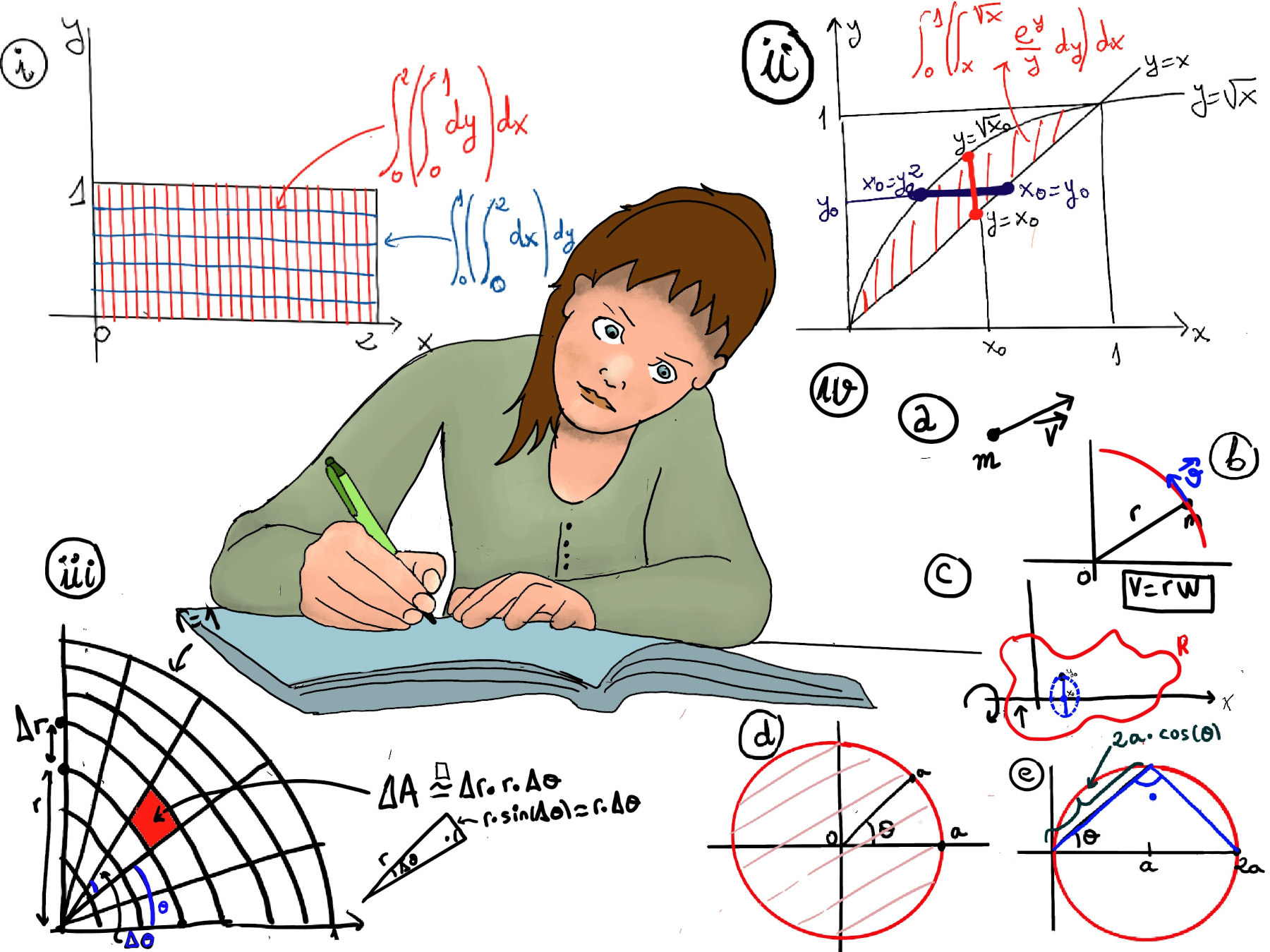
|
 |
 |

|
 |
 |
Give me six hours to chop down a tree and I will spend the first four sharpening the axe, Abraham Lincoln.
The definite integral of a function f(x), denoted as $\int_{a}^{b} f(x)dx$, will give you the signed area between the graph of the function and the x-axis over [a, b], that is, we subtract area below the x-axis from the area above the x-axis.
A double integral is an integral that integrates a function of two variables over a region R in a two-dimensional space. It represents the volume under a surface, that is, the volume below the graph z = f(x, y) (Figure 1).
It is denoted as $\iint_R f(x, y) dA$ Where R is the region over which the integration is performed; f(x,y) is the integrand, representing the function being integrated; and dA represents an infinitesimal area element in the region R (Figure 2).

Obviously, the formal definition will be reduced R into small pieces ΔAi and we will consider the sum $\sum_{i} f(x_i, y_i)ΔA_i$ and take the limits as ΔAi→ 0 (Figure 3).
Loosely speaking, to compute this integral, you would typically set up the limits of integration, perform the integration with respect to x, take slices (S(x) is the area of slice by yz-planes), so the volume would be $\int_{x_{min}}^{x_{max}} S(x)dx$. Then, S(x) = $\int_{y_{min(x)}}^{y_{max(x)}} f(x, y)dy$, hence $\iint_R f(x, y) dA\ = \int_{x_{min}}^{x_{max}} [\int_{y_{min(x)}}^{y_{max(x)}} f(x, y)dy]dx$ (Figure 4).


$\iint_R f(x, y) dA\ = \int_{0}^{1}(\int_{0}^{1} 1-x^2-y^2dy)dx =$[🚀]
$\int_{0}^{1} (1-x^2-y^2)dy = y -x^2y -\frac{y^3}{3}\bigg|_{0}^{1} = 1 -x^2 -\frac{1}{3} = \frac{2}{3} -x^2$
=[🚀] $\int_{0}^{1} (\frac{2}{3} -x^2)dx = \frac{2}{3}x - \frac{1^3}{3}x^3\bigg|_{0}^{1} = \frac{2}{3} - \frac{1}{3} - 0 + 0 = \frac{1}{3}$
Therefore, R (figure D) is a quarter disk where x2+ y2 ≤ 1, x ≥ 0, and y ≥ 0

$\iint_R f(x, y) dA\ = \int_{0}^{1}(\int_{0}^{\sqrt{1-x^2}} 1-x^2-y^2dy)dx =$[🚀]
$\int_{0}^{\sqrt{1-x^2}} 1-x^2-y^2dy = (y-x^2y-\frac{y^3}{3})\bigg|_{0}^{\sqrt{1-x^2}} = \sqrt{1-x^2}-x^2\sqrt{1-x^2}-\frac{1}{3}(1-x^2)^{\frac{3}{2}}=(1-x^2)\sqrt{1-x^2}-\frac{1}{3}(1-x^2)^{\frac{3}{2}} = (1-x^2)\sqrt{1-x^2}-\frac{1}{3}(1-x^2)^{\frac{3}{2}} = (1-x^2)\sqrt{1-x^2}-\frac{1}{3}(1-x^2)^{\frac{3}{2}} = (1-x^2)^{\frac{3}{2}}-\frac{1}{3}(1-x^2)^{\frac{3}{2}} = \frac{2}{3}(1-x^2)^{\frac{3}{2}}$
=[🚀] $\int_{0}^{1} \frac{2}{3}(1-x^2)^{\frac{3}{2}}dx =$[x = sin(θ), $(1-x^2)^{\frac{1}{2}} = cos(θ)$, dx = cos(θ)dθ] $\int_{0}^{\frac{π}{2}} \frac{2}{3}cos^4(θ)dθ =[cos^2(θ)=\frac{1+cos(2θ)}{2}] = \frac{2}{3}\int_{0}^{\frac{π}{2}}(\frac{1+cos(2θ)}{2})^2dθ =\frac{2}{3}\int_{0}^{\frac{π}{2}} (\frac{1}{4}+\frac{1}{2}cos(2θ)+\frac{1}{4}cos^2(2θ))dθ=[cos^2(θ)=\frac{1+cos(2θ)}{2}] = ··· = \frac{π}{8}$
When evaluating a double integral over a region, the order of integration refers to the sequence in which we perform integration with respect to different variables, e.g., $\int_{0}^{1} (\int_{0}^{2} dx)dy = \int_{0}^{2} (\int_{0}^{1} dy)dx$ (Figure i).

This method allows us to simplify calculations by choosing the most convenient order of integration based on the given problem.
The reader should realize that the following integral $\int_{0}^{1} (\int_{x}^{\sqrt{x}} \frac{e^y}{y}dy)dx$, in its actual form is impossible to compute. We are going to exchange the order, but this will normally affect the bounds of the integrals (Figure ii) and it is not necessarily easy to see, $\int_{0}^{1} (\int_{x}^{\sqrt{x}} \frac{e^y}{y}dy)dx = \int_{0}^{1} (\int_{y^2}^{y} \frac{e^y}{y}dx)dy$.
$\int_{y^2}^{y} \frac{e^y}{y}dx = \frac{e^y}{y}x\bigg|_{y^2}^{y}=e^y-e^yy$
$\int_{0}^{1} (\int_{x}^{\sqrt{x}} \frac{e^y}{y}dy)dx = \int_{0}^{1} (\int_{y^2}^{y} \frac{e^y}{y}dx)dy = \int_{0}^{1} (e^y-e^yy)dy =$[Integration by parts the second part of the integrand, ∫udv=uv−∫vdu where u = y, dv = eydy, du = dy, v = ey] $e^y-(ye^y-\int e^ydy)= 2e^y -ye^y\bigg|_{0}^{1} = 2e-e-2=e-2.$
In double or even triple integrals, we can also use change of variables to make the computation more manageable. For example, in polar coordinates, we replace x and y with $r\cos \theta$ and $r \sin \theta$, respectively, and adjust the limits of integration accordingly.
Recall the previously calculated $\int \int_{x^2+y^2≤1, x, y≥0} (1-x^2-y^2)dx$ and that polar coordinates specifies the location of a point P in the plane by its distance r from the origin and the angle θ made counterclockwise between the line segment from the origin to P and the positive x-axis (Figure iii).

Notice that ΔA ≈ Δr·rΔθ, dA = rdrdθ. Recall that the sine function (sin(Δθ)) relates the angle (Δθ) to the ratio of the length of the side opposite the angle to the length of the hypotenuse in a right triangle, and when $Δ\theta$ is very close to 0, we can make an approximation: $\sin(Δ\theta) \approx Δ\theta$, hence $Δ\theta ≈ Δr·rΔ\theta, dA = rdrdθ, \int \int fdA = \int (\int f·rdr)dθ$
$\int \int_{x^2+y^2≤1, x, y≥0} (1-x^2-y^2)dx$ =[x = rcosθ, y = rsin(θ), f = 1 -x2-y2 = 1 -r2] $\int_{0}^{\frac{π}{2}} (\int_{0}^{1} (1-r^2)rdr)dθ =$ [🚀]
$\int_{0}^{1} (1-r^2)rdr = \frac{r^2}{2}-\frac{r^4}{4}\bigg|_{0}^{1} = \frac{1}{2}-\frac{1}{4} = \frac{1}{4}$
= [🚀] $\int_{0}^{\frac{π}{2}} \frac{1}{4}dθ = \frac{1}{4}θ\bigg|_{0}^{\frac{π}{2}} = \frac{1}{4}·\frac{π}{2} = \frac{π}{8}$.